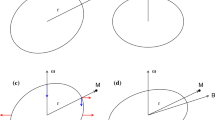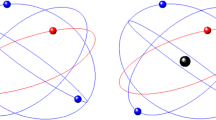Abstract
We consider the Clairaut theory of the equilibrium ellipsoidal figures for differentiated nonhomogeneous bodies in nonsynchronous rotation (Tisserand, Mécanique Céleste, t.II, Chaps. 13 and 14) adding to it a tidal deformation due to the presence of an external gravitational force. We assume that the body is a fluid formed by \(n\) homogeneous layers of ellipsoidal shape and we calculate the external polar flattenings \(\epsilon _k,\, \mu _k\) and the mean radius \(R_k\) of each layer or, equivalently, their semiaxes \(a_k\), \(b_k\), and \(c_k\). To first order in the flattenings, the general solution can be written as \(\epsilon _k=\mathcal {H}_k\epsilon _{h}\) and \(\mu _k=\mathcal {H}_k\mu _{h}\), where \(\mathcal {H}_k\) is a characteristic coefficient for each layer that depends only on the internal structure of the body and \(\epsilon _{h}\) and \(\mu _{h}\) are the flattenings of the equivalent homogeneous problem. For the continuous case, we study the Clairaut differential equation for the flattening profile using the Radau transformation to find the boundary conditions when the tidal potential is added. Finally, the theory is applied to several examples: (i) a body composed of two homogeneous layers, (ii) bodies with simple polynomial density distribution laws, and (iii) bodies following a polytropic pressure-density law.








Similar content being viewed by others
Notes
The exact relation is \(\epsilon _J = 3 \epsilon _M\frac{a^3}{r^3} \frac{M}{M+m_T}\). The approximation is valid only if the mass of the deformed body and the orbital eccentricity are small, that is \(r \simeq a\) and \(m_T << M\).
See Appendix C in the online supplement for more details.
For the details of the calculation of \(\delta V_2^{k}\), see Eq. (A.13) in Appendix A (in the online supplement).
An elementary calculation allows one to find the relationship \(\frac{C}{m_TR^2}\approx \frac{2}{3}\frac{\int _0^1 \widehat{\rho }z^4 \hbox {d}z}{\int _0^1 \widehat{\rho }z^2\hbox {d}z}=\frac{2}{5}\times \frac{3+\alpha }{5+\alpha }\).
References
Bizyaev, I.A., Borisov, A.V., Mamaev, I.S.: Figures of equilibrium of an inhomogeneous self-gravitating fluid. Celest. Mech. Dyn. Astron. 122, 1–26 (2015)
Borisov, A.V., Mamaev, I.S., Kilin, A.A.: The Hamiltonian dynamics of self-gravitating liquid and gas ellipsoids. Regul. Chaotic Dyn. 14, 179–217 (2009)
Bullen, K.E.: The Earth’s Density. Chapman and Hall, London (1975)
Chandrasekhar, S.: An Introduction to the Study of Stellar Structure. University of Chicago Press, Chicago (1939)
Chandrasekhar, S.: Ellipsoidal Figures of Equilibrium. Yale University Press, New Haven (1969)
Clairaut, A.C.: Théorie de la Figure de la Terre, Tirée des Principes de l’Hydrostratique. Paris Courcier, Paris (1743)
Collins, G.W.: The Fundamentals of Stellar Astrophysics. W.H. Freeman and Co., New York (1989)
Correia, A., Rodríguez, A.: On the equilibrium figure of close-in planets and satellites. Astrophys. J. 767, 128–132 (2013)
Darwin, G.H.: On the secular change in the elements of the orbit of a satellite revolving about a tidally distorted planet. Philos. Trans. 171, 713–891 (1880). (repr. Scientific Papers, Cambridge, Vol. II, 1908)
Esteban, E.P., Vazquez, S.: Rotating stratified heterogeneous oblate spheroid in Newtonian physics. Celest. Mech. Dyn. Astron. 81, 299–312 (2001)
Ferraz-Mello, S., Rodríguez, A., Hussmann, H.: Tidal frition in close-in satellites and exoplanets. The Darwin theory re-visited. Celest. Mech. Dyn. Astron. 101, 171–201 (2008). Errata: 104, 319–320
Ferraz-Mello, S.: Tidal synchronization of close-in satellites and exoplanets. A rheophysical approach. Celest. Mech. Dyn. Astron. 116, 109–140 (2013)
Hubbard, W.B.: Concentric Maclaurin spheroid models of rotating liquid planets. Astrophys. J. 768, 43 (2013)
Jardetzky, W.S.: Theories of Figures of Celestial Bodies. Interscience, New York (1958). (repr. Dover, Mineola, NY, 2005)
Jeans, J.: Astronomy and Cosmogony. Cambridge University Press, Cambridge (1929). (repr. Dover, New York, 1961)
Jeffreys, H.S.: The figures of rotating planets. Mon. Not. R. Astron. Soc. 113, 97 (1953)
Kong, D., Zhang, K., Schubert, G.: Shapes of two-layer models of rotating planets. J. Geophys. Res. 115, 12003 (2010)
Leconte, J., Lai, D., Chabrier, G.: Distorted, non-spherical transiting planets: impact on the transit depth and on the radius determination. Astron. Astrophys. 528, A41 (2011). Erratum: Astronomy & Astrophysics, 536, C1
Lyapounov, A.: Sur certaines séries de figures d’equilibre d’un liquide héterogène en rotation. Acad. Sci. URSS, Part I (1925)
Lyapounov, A.: Sur certaines séries de figures d’equilibre d’un liquide héterogène en rotation. Acad. Sci. URSS, Part II (1927)
Montalvo, D., Martínez, F.J., Cisneros, J.: On equilibrium figures of ideal fluids in the form of confocal spheroids rotating with common and different angular velocities. Rev. Mexicana Astron. Astrof. 5, 293–300 (1983)
Munk, W.H., MacDonald, G.J.F.: The Rotation of the Earth: A Geophysical Discussion. Cambridge University Press, Cambridge (1960)
Poincaré, H.: Figures d’equilibre d’una masse fluide (Leçons professées à la Sorbenne en 1900) Gauthier-Villars, Paris (1902)
Tisserand, F.: Traité de Mécanique Céleste, Tome II. Gauthier-Villars, Paris (1891)
Tricarico, P.: Multi-layer hidrostatic equilibrium of planets and synchronous Moons: Theory and application to Ceres and Solar System Moons. Astrophys. J. 782, 12 (2014)
Van Hoolst, T., Rambaux, N., Karatekin, Ö., Dehant, V., Rivoldini, A.: The librations, shape, and icy shell of Europa. Icarus 195, 386–399 (2008)
Wavre, R.: Figures planétaries et Géodesie. Gauthier-Villars et cie, Paris (1932)
Zharkov, V.N., Trubitsyn, V.P.: Figures planétaries et Géodesie. Astronomy and Astrophysics Series. Pachart, Tucson (1978)
Acknowledgments
The authors wish to thank one anonymous referee for comments and suggestions that helped to improve the manuscript. This investigation was supported by the National Council for Scientific and Technological Development (CNPq), Grants 141684/2013-5 and 306146/2010-0, and by St. Petersburg University, Grant 6.37.341.2015.
Author information
Authors and Affiliations
Corresponding author
Electronic supplementary material
Below is the link to the electronic supplementary material.
Rights and permissions
About this article
Cite this article
Folonier, H.A., Ferraz-Mello, S. & Kholshevnikov, K.V. The flattenings of the layers of rotating planets and satellites deformed by a tidal potential. Celest Mech Dyn Astr 122, 183–198 (2015). https://doi.org/10.1007/s10569-015-9615-6
Received:
Revised:
Accepted:
Published:
Issue Date:
DOI: https://doi.org/10.1007/s10569-015-9615-6




